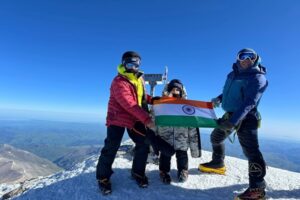For the first time in a decade, post-monsoon Everest — usually all but empty — will attract hard-core climbers with ambitious plans. Among them is Garrett Madison of Madison Mountaineering, who will guide a team of one Brit and three fellow Americans, including Mountain Hardwear CEO Joe Vernachio.
They will share the unusually empty mountain with Andrzej Bargiel, who will try to complete a ski descent from summit to Base Camp, as he did so successfully on K2 last year. Sharing the permit with Madison’s group is the secretive Kilian Jornet, who insists that he is just on a family holiday. Meanwhile, rumors fly about his plans for a new route on Everest and his use of Gorap Shep (instead of the Khumbu glacier) as Base Camp.
By contrast, while he was in Kathmandu, Garrett Madison was happy to open up to ExplorersWeb about his own climbing plans and opinions on Everest controversies.
Why did your team choose to tackle Everest in fall?
Because it will be an entirely different experience from the spring season. There will only be a few other climbers on the mountain, including some very good alpinists such as Kilian Jornet and Andrezj Bargiel.
What does it mean to fix the route on a lonely Everest? Do you plan to fix the entire route or only some sections?
We will do it all ourselves. The last two springs on Everest, our team fixed from Camp 2 to the summit. This time, we are responsible for the entire route, including from Everest Base Camp to Camp 2, a job normally done by the Ice Fall Doctors. We have hired two of these specialists to work with our Sherpas to accomplish this. It’s a big project.

“This time, we are responsible for fixing the entire route,” says Madison. Climbers in the Khumbu Icefall. Photo: Madison Mountaineering
Everest has been deserted in the fall for nearly 10 years. How did this project come about?
The President of Mountain Hardwear, Joe Vernachio, came up with the idea of attempting Everest in autumn as a way to product-test the high altitude clothing and equipment the company is known for, such as a Trango tent, their 75-litre pack and their down suit. Joe is also bringing a diverse team of MHW employees to Base Camp, so that they can experience first-hand the environment that their products support.
Tell us about the “less than ideal” conditions on Everest in fall? Is the route harder, or options for a summit bid fewer?
It’s more challenging on multiple levels. Besides fixing the entire route and establishing the high camps ourselves, conditions in the post-monsoon season are more winter-like — much more snow, colder temps, higher winds, and shorter days.
Everest climbing has received some fierce criticism after those images of the queues on the upper sections, and the number of casualties this year. Do you have any thoughts to share on the matter? Can climbing in fall solve that problem for those hoping to climb Everest without getting stuck in a traffic jam?
Yes, if things go well, I believe that autumn could become a viable alternative to spring. The reason for those crowds was that the weather window was very narrow, so most went for the summit on May 22 and 23. This created a lot of two-way traffic on the summit ridge, but it lasted for just a couple hours on a very small portion of the route.
In my opinion, there are two types of fatalities on Everest: those that are nearly unavoidable, such as heart attacks, stroke and Icefall collapse, and those that are clearly preventable, such as running out of oxygen and succumbing in the Death Zone. The reason most fatalities fall into the latter category is that people are unprepared.
There are essentially two types of [commercial] teams on Everest, guided and non-guided. Guided teams have a “mountain guide” or “expedition leader” who is in charge and decides when to go up and when to turn around. The leader sometimes has to tell a client that it’s time to turn around, so that they can make it back to Camp 4 and survive.
Non-guided expeditions provide all the logistics (permits, base camp services, oxygen, Sherpa support) but not an experienced person who calls the shots. So climbers sometimes get into a situation up high when they should turn around, but they choose not to, despite clear signals (low oxygen, fatigue, approaching bad weather) that this is the right decision. When these individuals make the wrong call, they sometimes pay the ultimate price.
Some Sherpa guides and company owners have publicly said that it’s not their job to turn a client around. That’s fine, as long as the client is qualified to make his or her own decision in the Death Zone. Prospective climbers need to research the companies they are considering, and honestly ask themselves if they should be climbing with a guide service or a logistics service. And it shouldn’t be cost that decides which one they should choose.

A climber approaches the summit of Everest, with Makalu in background. Photo: Madison Mountaineering
Back to the current expedition, are you only targeting Everest or do you have also plans for Lhotse?
Only Everest.
Will you collaborate on the mountain with other climbers?
Yes, I’m in contact with all of them. We will work together to accomplish our goals and return safely.
Without breaking any previous agreement, is there anything you could tell us about Kilian Jornet’s plans?
I think Kilian is attempting something very ambitious, that nobody else on earth could do. I’m very excited to see how it goes for him.
American Garrett Madison, 40, has guided Mt. Rainier since 1999 and topped out nearly 200 times. He has also led over 50 clients to the summit of Everest since 2009 and summited himself 10 times. He has also guided K2 and most of the Seven Summits.







